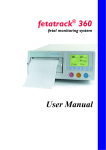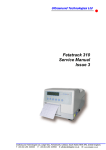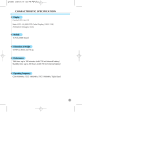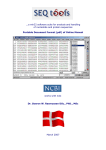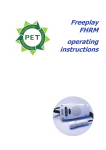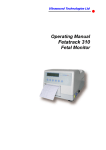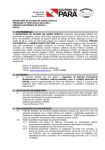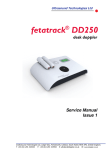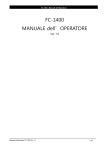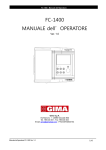Download fetaTRACK 310 - Ultrasound Technologies Ltd.
Transcript
® fetaTRACK 310 fetal monitoring system Operating Manual Issue 1.02 CONTENTS 1. ABOUT THIS MANUAL 2. ABOUT THE FETATRACK®310 3. SAFETY 4. SYMBOL DEFINITIONS 5. CONTROLS AND INDICATORS 5.1 Identification 5.2 Transducer Display 5.3 Printer Status Display 5 6 7 8 8 9 9 6. SOFT KEY FUNCTIONS (fn) 10 10 11 11 7. SETTING UP THE FETATRACK®310 12 12 13 13 14 14 8. OPERATING THE FETATRACK®310 15 15 16 17 18 18 19 19 19 20 21 21 21 21 22 22 22 23 23 23 23 24 6.1 6.2 6.3 Soft Key Menu Icons Operating the Soft Key Menu Alarm Status Menu 7.1 Electrical Connection 7.2 System Settings Menu 7.3 System Settings Descriptions 7.4Navigation 7.5 Exiting ‘System Settings’ mode 8.1 The Printer 8.2 Paper Out 8.3 Transducer Belts 8.4 Fetal Heart Rate Monitoring 8.4.1Ultrasound 8.4.2 Signal Quality 8.4.3 Audio Signal 8.4.4 General Guidance 8.4.5 Alarms 8.5 Uterine Activity Monitoring 8.5.1 External Uterine Pressure 8.5.2 Intrauterine Pressure 8.5.2.1 Contra-indications 8.5.2.2 Catheter Insertion 8.5.2.3 Preparation of IUP Transducer 8.5.2.4 Proceed with Monitoring 8.6 Direct Fetal ECG (FECG) 8.6.1 Contra-indications 8.6.2 Leg Lead Preparation 8.6.3 Leg Lead Connection 8.6.4 Fetal ECG Electrode Application 2 4 Fetatrack®310 Operating Instructions Copyright © Ultrasound Technologies Ltd 2012 8.6.5 8.7 Electrode to Leg Lead Connections Fetal Activity Monitoring 24 24 9. PREVENTATIVE MAINTENANCE 25 25 10. TROUBLESHOOTING 26 26 26 11. EQUIPMENT SPECIFICATION 27 27 28 29 29 30 31 12. WARRANTY 32 32 34 34 13. WEEE and RoHS 35 9.1 10.1 10.2 11.1 11.2 11.3 11.3.1 11.3.2 11.3.3 12.1 12.2 12.3 Cleaning Functional Checks Operational Checks FETATRACK®310 Device Specification Environmental Requirements Electromagnetic Compatibility Tables Manufacturers declaration and guidance : Emissions Manufacturers declaration and guidance : Immunity Manufacturers declaration and guidance: Separation Distances Terms and Conditions The Ultrasound Technologies CUSTOMER CARE PROMISE Meeting Expectations Fetatrack®310 Operating Instructions Copyright © Ultrasound Technologies Ltd 2012 3 1. ABOUT THIS MANUAL This user manual provides instructions for the operation of the FETATRACK®310 Cardiotocograph, hereafter referred to as FETATRACK®310. It is recommended that personnel study this manual before attempting to operate the FETATRACK®310 device. The safe and effective use of this equipment requires understanding of, and compliance with, all warnings, cautionary notices, and instructions marked on the product, and included in this manual. Typical users of FETATRACK®310 are trained medical professionals including, but not limited to, midwives, clinicians and other health professionals. If you have any queries regarding the operation of the FETATRACK®310 or understanding the information provided in this manual please contact: Ultrasound Technologies Ltd Lodge Way Portskewett Caldicot, NP26 5PS South Wales, United Kingdom Tel +44 (0) 1291 425425 Fax +44 (0) 1291 427093 [email protected] 4 Fetatrack®310 Operating Instructions Copyright © Ultrasound Technologies Ltd 2012 2. ABOUT THE FETATRACK®310 The FETATRACK®310 Cardiotocograph is a fetal monitor designed to provide cost effective care throughout pregnancy. The FETATRACK®310 can be configured as an Antepartum or Intrapartum monitor for use in maternity wards, antenatal clinics or doctor’s surgeries. The FETATRACK®310 can monitor fetal heart rates, using low power ultrasound or fetal ECG, external uterine pressure using an external tocodynamometer, and intrauterine pressure. Measurements are displayed on a large graphic LCD, while the data is recorded on a highresolution thermal printer. Fetal heart rates are monitored using Doppler ultrasound transducers. Up to three ultrasound transducers can be connected to a single FETATRACK®310 (Elite only), to track the heart rates of twins or triplets. The FETATRACK®310 has bradycardia and tachycardia alarm functionality, memory backup and an output socket for remote display of screen information on a compatible system. The FETATRACK®310 is supplied with the following accessories for each version: 310 basic 310 elite Wide Angle Ultrasound Transducer - US1 1 1 Wide Angle Ultrasound Transducer - US2 Optional Optional Wide Angle Ultrasound Transducer - US3 No Optional External Uterine Pressure Transducer - TOCO 1 1 Fetal Electrocardiogram Module - FECG No Optional Intrauterine Pressure Module - IUP No Optional Event Marker 1 1 Input Sockets 3 6 Elastic Belt 2 2/3/4 Chart Paper 1 1 Ultrasound Coupling Gel 0.25L 1 1 AC line Cord 1 1 Operating Manual 1 1 Fetatrack®310 Operating Instructions Copyright © Ultrasound Technologies Ltd 2012 5 3. SAFETY The FETATRACK®310 is designed to comply with EN60601-1 Class 1, with protective earth via the AC line cord. The FETATRACK®310 must be used with an appropriately rated and approved cord-set in accordance with the regulations of the country it is used in. When positioning the unit, ensure that access is available to the mains On/Off switch and power cable located on the rear of the unit. Should the electrical safety fuses have to be replaced, use only fuses of the type and rating defined on the rear label of the unit and in the Device Specification. If in doubt about the correct operation of the FETATRACK®310, fetal condition must be checked immediately by an alternative method. Fluids should not be allowed to enter the device as this may result in damage to the system. We would recommend that, to maintain the standard of performance of the FETATRACK®310, whenever possible, the monitor is included in a scheduled maintenance scheme. Only qualified personnel should service the device and the unit cabinet should not be opened except by these personnel due to the risk of hazardous electrical shock. All service requirements should be referred to an Ultrasound Technologies Ltd. authorised representative. WARNING: The FETATRACK®310 must not be used in the presence of flammable anaesthetics or oxygen rich environments. WARNING: US Federal Law restricts this device for sale on or by order of a physician. 6 Fetatrack®310 Operating Instructions Copyright © Ultrasound Technologies Ltd 2012 4. SYMBOL DEFINITIONS The following symbols have been used on the front and rear panels of the FETATRACK®310 and are here defined according to EN60101-1. Alternating Current Associated with Power On Indicator Type B Equipment Unit Classification Type BF Equipment Unit Classification Type CF Equipment Unit Classification Off (power: disconnection from the mains) On (power: connection to the mains) ! Attention, consult accompanying documents. Associated with auxiliary connections, see operating instructions. This symbol on the product or on its packaging indicates that this product must not be disposed of with your normal waste. Fetatrack®310 Operating Instructions Copyright © Ultrasound Technologies Ltd 2012 7 5. CONTROLS AND INDICATORS 5.1Identification 8 9 10 11 1 2 3 12 4 5 6 7 14 13 15 18 16 8 17 Fetatrack®310 Operating Instructions Copyright © Ultrasound Technologies Ltd 2012 5. CONTROLS AND INDICATORS 1 Power On indicator 10 Transducer Display 2 Activate the second function (fn) menu 11 Printer Status Display 3 Printer On/Off and speed control 12 Transducer connections 1,2,3 4 Ultrasound volume increase 13 Printer Door (pull to open) 5 Audio Selector for Ultrasound channels 14 Transducer connections 4,5,6 (310 Elite only) 6 Ultrasound volume decrease 15 Fuse Drawer and voltage selector 7 Set Uterine Pressure to zero (UA0) 16 Mains on/off switch 8 Date and Time display 17 Mains AC supply connector 9 Transducer connections display 18 Device serial number 5.2 Transducer Display 19 Focus Icon - Indicates active audio channel 20 Fetal Pulse Indicator 21 Transducer Identification 22 Fetal Heart Rate Colour coded to match associated transducer 23 Uterine Activity Reading The layout of the Ultrasound and ECG transducer display will adjust dependant on how many transducers are connected. This is to provide the clearest display of all the readings of connected transducers. The Uterine Activity readings remain in the same location on the display regardless of which other transducers are connected. 5.3 Printer Status Display 24 Paper Out Indicator 25 Printer Speed Indication Fetatrack®310 Operating Instructions Copyright © Ultrasound Technologies Ltd 2012 9 6. SOFT KEY FUNCTIONS (fn) 6.1 Soft Key Menu Icons Key Icon Function 2 Exit soft key menu or return to previous menu. 3 Operator event indicator: Prints an event mark on the paper. Mark appears on top edge of FHR scale. 7 Alarm status menu: Displays the current alarm status and give access to alarm options. F310 Elite Only 4 Switches the display between trace mode and numeric display mode. The target mode will appear as the soft key icon. 5 Switches between split trace mode or combined (normal) mode printing. Only available when graticule printing is enabled in system settings. Alarm Status Menu 4 Low FHR Alarm. This indicates that the Low FHR alarm is enabled. Press the associated key on the control panel (4) to disable/enable this alarm. 5 High FHR Alarm. This indicates that the High FHR alarm is enabled. Press the associated key on the control panel (5) to disable/enable this alarm. 6 Bradycardia Alarm. This indicates that the Bradycardia alarm is enabled. Press the associated key on the control panel (6) to disable/enable this alarm. 7 Tachycardia Alarm. This indicates that the Tachycardia alarm is enabled. Press the associated key on the control panel (7) to disable/enable this alarm. This line is drawn across an alarm symbol to indicate that the alarm is disabled. 10 Fetatrack®310 Operating Instructions Copyright © Ultrasound Technologies Ltd 2012 6. SOFT KEY FUNCTIONS (fn) 6.2 Operating the Soft Key Menu The soft key menu will appear when the ‘fn’ key (2) is pressed during normal operating mode. The menu will appear at the bottom of the display and will disappear again after 10 seconds if no further keys are pressed. When the soft key menu is visible the control panel keys do not carry out the functions marked on them. Instead the keys will activate the functions shown on the display directly above the keys. The table above gives a brief description of the functions of the soft keys which may appear. Not all the controls will appear on the FETATRACK®310 Basic and these soft keys will have no effect. 6.3 Alarm Status Menu The Alarm Status menu displays the current state of the alarm system. Only alarms that are enabled in the System Settings menu will appear in this menu. Alarms can be enabled or disabled by pressing the associated soft key when the menu is visible. A line will be drawn through an alarm that is disabled, and the line removed for an alarm that is enabled. Further alarm settings are accessed through the System Settings, see “SETTING UP THE FETATRACK®310”. Fetatrack®310 Operating Instructions Copyright © Ultrasound Technologies Ltd 2012 11 7. SETTING UP THE FETATRACK®310 7.1 Electrical Connection The FETATRACK®310 will operate with a mains input voltage between 100 and 260 volts AC, 50 or 60 Hz. Ensure that the correct voltage is selected before connecting the unit to the mains supply. The FETATRACK®310 is fitted with a dual-range mains power supply, which can be changed externally to suit the local AC line voltage. The currently selected voltage is displayed in the window of the fuse drawer (15), located on the rear of the unit. To select a different voltage, ensure the unit is switched off and the AC power cord is not connected. Open the fuse door (15) using a small flat blade screwdriver and remove the fuse tray using the screwdriver. Turn over the fuse tray 180˚ and re-insert in the fuse drawer. The new voltage should now be visible through the window of the fuse door once it has been closed. Connect the AC supply cord and switch on the FETATRACK®310. The AC input on/off switch (16) is located on the rear of the unit adjacent to the AC line input socket (17). Observe that the front panel power on indicator (1) is illuminated when the unit is switched on. The FETATRACK®310 is now operational and the display will indicate the operating mode. FETATRACK®310 Elite displaying ‘trace mode’ operating screen 12 Fetatrack®310 Operating Instructions Copyright © Ultrasound Technologies Ltd 2012 7. SETTING UP THE FETATRACK®310 7.2 System Settings Menu Hold down the “fn” button (2) whilst turning on the FETATRACK®310, to enter the System Settings mode . 7.3 System Settings Descriptions Description Options a1 Set Time Hours : Minutes a2 Set Date Day / Month / Year a3 Low FHR Alarm type and level Low Value/Bradycardia/Off : FHR level a4 High FHR Alarm type and level High Value/Tachycardia/Off : FHR level b1 TOCO baseline level 0-20 b2 TOCO filtering level 1/2 b3 TOCO scale 100, 200, 300, 400 b4 Printed Scale for FHR 20/30 bpm/cm c1 Auto Fetal Movement detection On/Off c2 Default printer speed 1, 2, 3 cm/min c3 Print Graticule on paper Print / Don’t Print c4 Print header language English, Spanish, German, Off Fetatrack®310 Operating Instructions Copyright © Ultrasound Technologies Ltd 2012 13 7. SETTING UP THE FETATRACK®310 7.4Navigation To navigate the SETUP screen, use the control panel keys below the desired soft key icon. The soft keys provide the following controls: ‘fn’ key (2) Save and Exit ‘Printer Speed’ key (3) Navigate Left ‘Volume Increase’ key (4) Navigate Up / Increase Value ‘Audio Selector’ key (5) Select / Confirm ‘Volume Decrease’ key (6) Navigate Down / Decrease Value ‘UA Zero’ key (7) Navigate Right To select a setup option for editing, navigate to the desired setting using the four navigation keys. Once the required option is highlighted press the “Select/Corfirm” key (5), the setting can now be adjusted using the Increase/Decrease Value keys (4,6). If more than one value can be adjusted in a setting, such as “Time & Date”, use the ‘Navigate Left/Right’ keys (3,7) to switch between values, eg. Hours and Minutes. Once the setting has been adjusted press the ‘Select/Confirm’ key (5) again to store the udpated value and return to the setting navigation. 7.5 Exiting ‘System Settings’ mode To exit the system setting mode and save any changes made, press the ‘Save and Exit’ key (2). The system will restart and any changes made to the setup will become active. To exit the system setting mode without saving, switch the FETATRACK®310 off without pressing the ‘Save and Exit’ key to store the changes. The system will then start up with the previous settings when switched back on. 14 Fetatrack®310 Operating Instructions Copyright © Ultrasound Technologies Ltd 2012 8. OPERATING THE FETATRACK®310 8.1 The Printer The FETATRACK®310 prints on thermo-sensitive z-fold paper using a high resolution thermal matrix printer. The data is presented to the thermal printer digitally and therefore no calibration is necessary. Heart rate, uterine activity and fetal movement are recorded together with event marks, alarm indication, date, time, recorder speed, operating mode and alarm status. i. ii. iii. iv. To load the paper pack in the printer, open the printer door by pulling the door open (i), giving easy access for paper loading(ii). Open two pages of paper from the beginning of the paper pack, with the thermal sensitive side uppermost and then place the pack in the bottom of the printer tray (iii). Make sure that the paper is properly positioned; pull the free end of the pack over the roller and close the door with the paper coming out over the top edge of the printer door (iv). The chart pack will self align once the recorder is running. To operate the printer, press the Printer On/Off switch (2) on the front panel. The printer will start to run and the chart speed will be shown in the display. To turn the printer off, press and hold the printer on/off switch (2) until the printer stops. A few centimetres of paper will be fed out at high speed. The FETATRACK®310 printer will record at 1, 2 or 3 cm/min. To change the speed during recording simply press the printer on/off switch (2) momentarily. Fetatrack®310 Operating Instructions Copyright © Ultrasound Technologies Ltd 2012 15 8. OPERATING THE FETATRACK®310 The FETATRACK®310 is pre-set to run at a default speed and will always start at this speed every time the printer is turned on. For details of how to change the default speed see the section entitled “SETTING UP THE FETATRACK®310”. A data block can be printed on the paper at the start of recording, this contains Patient Name, Gestational Age, Patient Number, Hospital / Doctor and Bed Number. For details of how to change the printed language and data entry, see the section entitled “SETTING UP THE FETATRACK®310”. 8.2 Paper Out In the event that the paper pack is exhausted during recording the printer will automatically turn off. The display will indicate “Paper Out” and the unit will emit an audible beep. Load a new paper pack as described above and close the recorder door. During the time taken to change the paper pack the unit will store the trace data in its internal memory. This stored data will be printed at high speed once a new paper pack is loaded. In this way a complete recording may be obtained without any loss of information whilst the printer is reloaded. To recommence recording press the printer on/off switch (2) momentarily. Once the memory printout is complete the printer will continue to record at the selected speed. The printer may also be turned off while the paper pack is changed if the printer on/ off switch (2) is pressed and held before opening the printer door. In this case there is no automatic printout of data at the recommencement of recording. 16 Fetatrack®310 Operating Instructions Copyright © Ultrasound Technologies Ltd 2012 8. OPERATING THE FETATRACK®310 8.3 Transducer Belts Both the ultrasound and contractions transducers are held in position with elastic belting which maintains the active elements in contact with the abdomen. The belt should first be placed around the patient before securing in place, at the correct tension, over the plastic button on the rear of the transducer. Place the belt around the patient Place the transducer on the abdomen Place one end of the belt over the button on the Tension the belt and place the remaining end over rear of the transducer the button on the transducer to secure the belt Fetatrack®310 Operating Instructions Copyright © Ultrasound Technologies Ltd 2012 17 8. OPERATING THE FETATRACK®310 8.4 Fetal Heart Rate Monitoring 8.4.1Ultrasound The FETATRACK®310 Ultrasound Transducers are used to detect the fetal heart beat. The transducers are colour coded for ease of identification. 1.5MHz 1.6Mhz 1.7Mhz Any combination of transducers can be used to track up to 3 fetal heart rates, however only one of each colour transducer may be used at a time. To monitor the first heart rate, push the transducer plug (any of the 3 transducers may be chosen) firmly into the front panel socket of your choice and turn the FETATRACK®310 on. A second heart rate channel may be used simultaneously to monitor twins externally by connecting a second ultrasound transducer to any other socket. This transducer must be a different colour to the transducer used to track the first fetal heart rate. Single FHR Twins FHR Triplets FHR US1 US1 & US2/US3 US1 & US2 & US3 US2 US2 & US1/US3 US3 US3 & US1/US2 Locate a clear fetal heart sound using a Doppler Fetal Heart Detector (FETATRACK®120 or similar). Place an elastic belt around the patient, see “Transducer Belts” above. Apply a liberal amount of coupling gel to the transducer face and place the transducer on the abdomen, locating it approximately in the position determined by the Doppler detector. Secure the transducer in place using the elastic belt, as described above. Ensure that the belt tension is sufficient to hold the transducer in good contact with the abdomen. The heart rate processor will start to calculate heart rate within a few seconds and the heart rate can be observed on the digital display. Correct operation can be verified by observing that the heart shaped fetal pulse indicator is flashing at the audible heart rate. 18 Fetatrack®310 Operating Instructions Copyright © Ultrasound Technologies Ltd 2012 8. OPERATING THE FETATRACK®310 8.4.2 Signal Quality The fetal pulse heart is also used as a signal quality indicator. When positioning the transducer, observe the fetal pulse heart, which should flash solid under best signal conditions. If the flashing heart is hollow, this is an indication that the signal quality is not at its optimum. Improved recordings can be obtained by repositioning the transducer so that the heart flashes solid. No Signal Poor Signal Good Signal When the fetal pulse heart changes to hollow, a black dot or line is marked on the recording for the time that signal quality remains low. No mark is made in the absence of signal, or when signal quality is adequate for correct positioning. Low signal quality is marked on the lower edge of the fetal heart rate scale. 8.4.3 Audio Signal When monitoring more than one fetus it is possible to listen to each of the ultrasound channels by pressing the Audio Selector Switch (5). The display will indicate the selected channel with the focus icon (19). The audio volume of the selected ultrasound channel can be adjusted by pressing the volume increase (4) and volume decrease (5) control buttons. Once a clear fetal heart signal has been located, turn the printer on and observe that the digital display of fetal heart rate (FHR) and chart record are in agreement, taking into account that the recording is a few seconds behind the display. 8.4.4 General Guidance Transducer position should be checked at least half-hourly during labour monitoring or prolonged NST. When repositioning the transducer, further coupling gel may be required. When repositioning the transducers always ensure that the fetal pulse icon flashes solid, to ensure good quality recordings and heart rate tracking. Results will vary from one patient to another, but in all cases good transducer positioning is essential, and this may be aided by the use of a liberal amount of coupling gel. It is also important that the belts are correctly tensioned to maintain good contact with the abdomen. Fetatrack®310 Operating Instructions Copyright © Ultrasound Technologies Ltd 2012 19 8. OPERATING THE FETATRACK®310 With the fetus in the vertex presentation and the mother sitting or supine the clearest sound will normally be found on the midline below the umbilicus. In the lateral position clearer sounds may be found with the transducer displaced from the center line to the upper surface of the abdomen. The clearest signals in breach presentation may be located higher and to one side. Transducer position which results in sounds with a strong placental or cord signal should be avoided, as these frequently render traces with artifacts. It is important that a distinct fetal heart sound is present during monitoring for correct function of the FETATRACK®310. Any doubt about fetal viability should be checked by listening to the audible signal, or by an alternative diagnostic technique. A simple check of the ultrasonic system can be made by holding the transducer against the palm of the hand and stroking the back of the hand at a fixed rate, say twice per second. A clear audible signal should be heard and the digital display should show a rate after approximately five seconds. With the printer running this rate will be recorded on the chart. 8.4.5Alarms The FETATRACK®310 can detect both high and low fetal heart rates, providing an alarm signal if required. If an alarm condition arises, the FETATRACK®310 emits an intermittent beep. The chart recording indicates an alarm state with a down arrow marked with an “A” on the top edge of the chart. Pressing either volume button resets the alarm. The current settings for the alarms can be accessed through the “soft key” menu, by selecting the “Alarm status menu” . Active alarms may be de-activated by selecting them with the control panel key below the icon. The alarm settings can be adjusted in the SETUP screen, see section “SETTING UP THE FETATRACK®310”. Alarm settings are printed between the chart scales on every page of the recording. A low heart rate alarm may be set between 90 and 120 BPM in steps of 5 BPM. The alarm can be set to trigger based on a low heart rate value, by Bradycardia detection, or can be switched off. A high heart rate alarm may be set between 160 and 190 BPM in steps of 5 BPM. The alarm can be set to trigger based on a high heart rate value, by Tachycardia detection, or can be switched off. 20 Fetatrack®310 Operating Instructions Copyright © Ultrasound Technologies Ltd 2012 8. OPERATING THE FETATRACK®310 8.5 Uterine Activity Monitoring 8.5.1 External Uterine Pressure The FETATRACK®310 External Uterine Pressure (tocodynamometer) transducer is used to monitor external uterine activity. The transducer is colour coded yellow for ease of identification. To monitor uterine activity plug the transducer into the input socket of your choice. The FETATRACK®310 TOCO transducer is sealed to prevent the ingress of fluids, nevertheless no coupling gel or other fluid should come into contact with the transducer face. Place the transducer on the center line over the fundus in a position where the uterus is firm and secure in place with stretch belting. As with the ultrasound transducer the belt should first be secured in position and then the transducer slid onto it. Once the transducer is in position, push the UA0 button (7) on the front panel to zero the recording. The position of the zero baseline can be set to suit individual preference, see the section “SETTING UP THE FETATRACK®310”. 8.5.2 Intrauterine Pressure Actual intrauterine pressure (IUP), including contraction intensity and uterine tone (pressure between contractions), is measured using an intrauterine catheter and pressure module. To use an intrauterine catheter and pressure transducer the membranes must be ruptured and the cervix dilated at least 2 cm. Note: If both the heart rate and uterine activity are to be monitored using internal techniques, it is generally recommended to insert the uterine catheter before the ECG electrode is attached if possible. Note: The intrauterine pressure module is not supplied as standard with the FETATRACK®310. For advice on connection of an IUP module contact Ultrasound Technologies Ltd or your supplier. 8.5.2.1Contra-indications Do not insert catheter unless membranes are ruptured. Do not use catheter if there is bleeding from the uterine cavity. Do not use catheter if there is uterine infection or placenta previa. Fetatrack®310 Operating Instructions Copyright © Ultrasound Technologies Ltd 2012 21 8. OPERATING THE FETATRACK®310 8.5.2.2 Catheter Insertion Because there are several alternative designs of uterine catheterisation kits, insertion techniques are considered to be beyond the scope of this manual. Consult instructions included with the manufacturer’s package for proper insertion technique. WARNING: MEMBRANES MUST BE RUPTURED PRIOR TO CATHETER INSERTION. DO NOT USE THE INTRAUTERINE CATHETER IF THERE IS BLEEDING FROM THE UTERINE CAVITY OR IF UTERINE INFECTION OR PLACENTA PREVIA IS PRESENT. 8.5.2.3 Preparation of IUP Transducer Plug the IUP module connector into an available socket on the front panel of the FETATRACK®310. Because there are several alternative designs of IUP transducer which may be used with the FETATRACK®310 it is necessary to consult the specific instructions supplied with the transducer. If using an external transducer with fluid-filled coupling the system must be flushed and primed to remove air bubbles prior to use. The relative UA zero may be set by pressing the front panel UA0 key (7) on the control panel. Note: The zero setting may drift slightly until the entire system is at room temperature. 8.5.2.4 Proceed with Monitoring Turn the printer on and check whether the UA recording is adequate. Between the contractions the UA channel will not return to zero. This is the measure of the uterine resting tone. If, during monitoring, the UA channel does not appear to be accurately plotting contractions or the tracing of the contractions looks “sluggish”, you should suspect the catheter tip has either collected debris from the amniotic fluid or contains air bubbles, depending on the type in use. Follow the manufacturer’s instructions to clear any obstruction and continue recording. To check that the system is operational, it is often helpful to ask the patient to cough which should produce an artifact on the strip chart record. Note: Since the pressure should never read below zero, this would be considered a fault condition and an error will be displayed. The error is reported in the Transducer Connection 22 Fetatrack®310 Operating Instructions Copyright © Ultrasound Technologies Ltd 2012 8. OPERATING THE FETATRACK®310 Display (9), highlighting the IUP Symbol in Red. If such a condition develops, check the catheter connections and repeat the UA zero procedures, replace the IUP transducer if necessary. 8.6 Direct Fetal ECG (FECG) The Fetal ECG (internal method of obtaining FHR) is generally considered to be the most accurate and reliable method available. To apply the fetal ECG electrode, the membranes must be ruptured and there must be at least 2 cm cervical dilation. WARNING: BECAUSE THE TIP OF THE FETAL ELECTRODE IS DESIGNED TO PENETRATE THE FETAL SKIN, IT MAY PRESENT THE POSSIBILITY OF TRAUMA, HAEMORRHAGE OR INFECTION. THEREFORE THESE ELECTRODES SHOULD ONLY BE USED UNDER ASEPTIC CONDITIONS. MEMBRANES MUST BE RUPTURED PRIOR TO ELECTRODE APPLICATION. Note: If both the heart rate and uterine activity are to be monitored using internal techniques, it is generally recommended to insert the uterine catheter before the ECG electrode is attached if possible. 8.6.1Contra-indications Do not use a fetal ECG electrode if you cannot identify the fetal presenting part to which the electrode is to be attached. Do not attach the electrode to the fetal face, fontanelles or genitalia. Do not use the electrode if uterine infection or placenta previa is present. 8.6.2 Leg Lead Preparation Prepare an area high on the patient’s thigh or on the lower abdomen by cleaning with an alcohol swab. Allow to dry. Apply the leg electrode to the prepared area and fix in place with Safelink Attachment Pad. (Details on LifeTrace Safelink Instructions) 8.6.3 Leg Lead Connection Plug the Fetal ECG module cable connector into an available socket on the front panel of the FETATRACK®310, making sure that it is pushed firmly in. Fetatrack®310 Operating Instructions Copyright © Ultrasound Technologies Ltd 2012 23 8. OPERATING THE FETATRACK®310 8.6.4 Fetal ECG Electrode Application Explain the procedure to the patient. Because there are several alternative designs of Fetal ECG Electrodes, application techniques are considered to be beyond the scope of this manual. Consult the instructions included with the manufacturer’s package for proper technique. 8.6.5 Electrode to Leg Lead Connections The FETATRACK®310 uses the Life Trace Safelink fetal scalp system, the fetal scalp electrode plugs into the end of the leg plate. (Details on LifeTrace Safelink Instructions) Turn the FETATRACK®310 on and check that for every heartbeat, as indicated by the flashing fetal pulse heart, an audible beep may be heard. Adjust the audio volume as described in the Ultrasound: Audio Signal section (8.4.3). Turn the printer on and observe that the digital display of FHR and the chart record are in agreement. 8.7 Fetal Activity Monitoring Fetal activity may be recorded with the assistance of the patient. A hand-held Event Marker switch is provided for this purpose and this is plugged into any socket on the front of the FETATRACK®310. If the patient feels fetal movement she may press the switch and this will mark the paper with an arrow at the bottom edge of the FHR scale. The midwife may also use the Event Marker to indicate any changes made during the procedure, such as repositioning of the transducers, or movement of the patient. Events can also be marked using the control panel on the FETATRACK®310, as explained in the “Soft Key Functions” section of this manual. The FETATRACK®310 also has ultrasound detected, automatic movement identification. When set to active, the low frequency movements of the fetus are detected, a movement event is printed on the paper using an arrow at the bottom edge of the FHR scale. A letter A is printed next to the arrow to indicate automatic detection. 24 Fetatrack®310 Operating Instructions Copyright © Ultrasound Technologies Ltd 2012 9. PREVENTATIVE MAINTENANCE To ensure continued accuracy and reliability from your monitor you should regularly perform the following routine maintenance tasks. 9.1Cleaning • Maintain a clean environment for the monitor. • Switch the monitor off and disconnect the AC line supply cable and transducers. • Wipe the case with a cloth dampened with an aqueous disinfectant. • Remove all coupling gel, blood, saline, etc., as soon as possible after use. • Wipe dry with a clean cloth. • NEVER Autoclave the transducers. The transducers should be cleaned with a sterile non-abrasive cloth dampened with an aqueous disinfectant. If, in extreme cases, it is considered necessary to sterilize the transducer this should be done using gas sterilization methods at pressure and at elevated temperature in accordance with hospital practice. Note that out-gassing periods should be adhered to. • NEVER clean transducers with alcohol based cleaners or wipes. • The print head may be cleaned by GENTLY wiping with a soft cloth moistened with alcohol until ink deposits have been removed. Fetatrack®310 Operating Instructions Copyright © Ultrasound Technologies Ltd 2012 25 10. TROUBLESHOOTING If you suspect a problem with your monitor complete the following checks before calling your service agent. 10.1 Functional Checks • Make sure the AC line cable is connected. • Make sure the power switch is on. • Check that the power on indicator is illuminated. • Make sure the recorder is correctly loaded and the door closed. • Turn the recorder on and confirm that the printer speed is displayed. • Check that the chart paper is moving. 10.2 Operational Checks • Make sure all connectors are firmly plugged in, that the transducers are correctly positioned and the audio volume set to the desired level. • Observe that the appropriate fetal pulse lamp flashes with each heart beat. • If the problems still persist replace the suspect transducer with a spare if available. Note: If the monitor does not perform as described above call your service agent. Be ready to provide the model and serial numbers (18) and the nature of the problem. There are no user serviceable parts inside the monitor. A fully comprehensive Service Manual is available to qualified personnel. 26 Fetatrack®310 Operating Instructions Copyright © Ultrasound Technologies Ltd 2012 11. EQUIPMENT SPECIFICATION 11.1 FETATRACK®310 Device Specification Ultrasound Type Transducer Operating Frequency Power output Audio Range Heart Rate Processing External Uterine Activity Type Response Signal Range Alarms Low Level Process High Level Process Paper Out Printer Printhead Resolution Speeds Print Speed Accuracy Paper Chart scale Paper type Display Display Type Display Size Display Data Numeric Display Data Graphical Display/Printer Ranges FHR Ranges FHR Accuracy UA Range Continuous Doppler Multi element wide angle 1.5MHz ±2% or 1.6MHz ±2% or 1.7MHz ±2% 5mW/cm2 max. SATA Response 300 to 1KHz 30 to 250 bpm High resolution multi point digital autocorrelator Differential external pressure transducer 0 to 5 Hz 0 - 110 relative contractions strength 90 -120BPM, adjustable in steps of 5BPM Bradycardia algorithm or level sense 160 -190BPM, adjustable in steps of 5BPM Tachycardia algorithm or level sense Last paper sheet taken 128 mm thermal array printhead 8 dots / mm 1,2,3, cm / min Better than 1% 145mm wide x 100mm page x 15M long, z-fold pack FHR: 20 or 30 b/cm UA: 0—100 Pre-printed or plain black thermal Full colour, LED backlit, graphic LCD 115 x 86mm FHR, UA, Print Speed FHR, UA 30-240BPM ±1BPM 0-110 units Fetatrack®310 Operating Instructions Copyright © Ultrasound Technologies Ltd 2012 27 11. EQUIPMENT SPECIFICATION Power Supply AC input voltage Frequency Power Fuses Safety Enclosure Material Weight Size Event Marker Hand Held Keypad Automatic Computer interface Standard 11.2 100–130 VAC or 200–260 VAC 46 – 64 Hz 30 VA High Breaking Capacity - T0.25A 230V or T0.50A 115V Complies with EN60101-1 Class 1 Type B PC ABS 4Kg 290 x 260 x 220mm User operated pendant switch User operated soft key Ultrasound Transducer detected RS232, 9600 baud, 8 bits no parity 1 stop bit Environmental Requirements Operating Ambient +10°C to +40°C Temperature Relative Humidity 30 – 70% non-condensing Ambient Pressure 700 kPa to 1060 kPa Transit and Storage Ambient -40°C to +70°C Temperature Relative Humidity 10% to 100%, including condensation Ambient Pressure 500 kPa to 1060 kPa 28 Fetatrack®310 Operating Instructions Copyright © Ultrasound Technologies Ltd 2012 11. EQUIPMENT SPECIFICATION 11.3 Electromagnetic Compatibility Tables As detailed in the Specifications, this product is classified as a Class A Group 1 type of product according to EN55011. This product is allowed in a domestic establishment under the jurisdiction of a Healthcare professional. The FETATRACK®310 is designed to comply with EN60601-1, Medical Electrical Requirements for Safety and is a Class 1 device. 11.3.1 Manufacturers declaration and guidance : Emissions Care has been taken through the design and manufacturing process to minimize the electromagnetic (EM) emissions which may be produced by this equipment. However, in the unlikely event that the unit causes an EM disturbance to adjacent equipment, we suggest that the procedure is performed out of range of the affected equipment. Electromagnetic Emission The Fetatrack310 is intended for use in the electromagnetic environment specified below. The user of the Fetatrack310 should assure that it is used in such an environment. Emission Test Compliance Electromagnetic Environment RF Emissions CISPR II Group 2 The Fetatrack310 must emit electromagnetic energy in order to perform its intended function. Nearby electronic equipment may be affected. RF Emissions CISPR II Class B Harmonic emissions IEC 61000-3-4 Class A Voltage Fluctuations / flicker emissions IEC61000-3-3 Complies The Fetatrack310 is suitable for use in all establishments other than domestic, and may be used in domestic establishments and those directly connected to the public low-voltage power supply network that supplies buildings used for domestic purposes, providing the following warning is heeded. WARNING: This equipment/system is intended for use by healthcare professionals only. This equipment/system may cause radio interference or may disrupt the operation of nearby equipment. It may be necessary to take mitigating measures, such as re-orienting or relocating the Fetatrack310 or shielding the location Fetatrack®310 Operating Instructions Copyright © Ultrasound Technologies Ltd 2012 29 11. EQUIPMENT SPECIFICATION 11.3.2 Manufacturers declaration and guidance : Immunity If the user has any doubt regarding the unit’s EM immunity during routine operation, we suggest that the source of EM disturbance is identified and its emissions reduced. Electromagnetic Immunity The Fetatrack310 is intended for use in the electromagnetic environment specified below. The user of the Fetatrack310 should assure that it is used in such and environment. Immunity Test IEC60601 test level Compliance level Electromagnetic Environment - guidance Electrostatic Discharge (ESD) IEC61000-4-2 ±6KV contact ±8KV air ±6KV contact ±8KV air Floors should be wood, concrete or ceramic tile. f the floor is covered in synthetic material the relative humidity should be at least 30% Portable and mobile RF communications equipment should be used no closer to any part of the Fetatrack310 including cables, than te recommended separation distance calculated from the equation applicable to the frequency of the transmitter. Radiated RF IEC 61000-4-3 3V/m 80MHz to 2.5GHz 3V/m d=1.2√P (80MHz to 800MHz) d=2.3√P (800MHz to 2.5GHz) Where P is the maximum output power rating of the transmitter in watts (W) according to te transmitter manufacturer and d is the recommended separations distance in meters (m). Field strengths from fixed RF transmitters, as determined by an electomagnetic site survey (a), should be less than the compliance level in each frequency range (b). Interference may occur in the vicinity of equipment marked the following symbol: with Note 1: At 80 MHz and 800 MHz, the higher frequency range applies. Note 2: These guidelines may not apply in all situations. Electromagnetic propagation is affected by absorption and reflection from structures, objects, and/or people. a. Field strengths from fixed transmitters, such as base stations for radio (cellular / cordless) telephones and land mobile radios, amateur radio, AM and FM radio broadcast and TV broadcast cannot be predicted theoretically with accuracy. To assess the electromagnetic environment due to fixed RF transmitters, an electromagnetic site survey should be considered. If the measured field strength in the location in which the Fetatrack310 device is used exceeds the applicable RF compliance level above, the Fetatrack310 device should be observed to verify normal operation. If abnormal performance is observed, additional measures may be necessary, such as re-orienting or relocating the device. b. Over the frequency range 150 kHz to 80 MHz, field strengths should be less than 3 V/m. 30 Fetatrack®310 Operating Instructions Copyright © Ultrasound Technologies Ltd 2012 11. EQUIPMENT SPECIFICATION 11.3.3 Manufacturers declaration and guidance: Separation Distances Recommended separation distances between portable and mobile communications equipment and a Fetatrack310 The Fetatrack310 is intended for use in an electromagnetic environment in which RF disturbances are controlled. The user of the Fetatrack310 can help prevent electromagnetic interference by maintaining a minimum distance between portable and mobile RF communications equipment (transmitters) and the Fetatrack310 as recommended below, according to the maximum output power of the communications equipment. Rated maximum output power of transmitter (W) Separation distance according to frequency of transmitter (m) 150KHz to 80MHz d=1.2√P 80MHz to 800MHz d=1.2√P 800MHz to 2.5GHz d=2.3√P 0.01 0.12 0.12 0.23 0.1 0.38 0.38 0.73 1 1.2 1.2 2.3 10 3.8 3.8 7.3 100 12 12 23 For transmitters rated at a maximum output power not listed above, the recommended separation distance d in meters (m) can be estimated using the equation applicatble to the frequency of the transmitter, where P is the maximum output power rating of the transmitter in watts (W) according to the transmitter manufacturer. Note 1: At 80 MHz and 800 MHz, the higher frequency range applies. Note 2: These guidelines may not apply in all situations. Electromagnetic propagation is affected by absorption and reflection from structures, objects, and/or people. This equipment complies with the essential requirements of the European Council Directive 93/42/EEC + 2007/47/EC relating to Medical Devices. Fetatrack®310 Operating Instructions Copyright © Ultrasound Technologies Ltd 2012 31 12. WARRANTY 12.1 Terms and Conditions 1. The Warranty Ultrasound Technologies Ltd warrants the product, when new, to be free of defects in material and workmanship and to perform in accordance with the manufacturer’s specification for a minimum period of three years from the date of purchase from Ultrasound Technologies Ltd. 2. Replacement of Product or Components Ultrasound Technologies Ltd will repair or replace any components found to be defective or at variance from manufacturer’s specification at no cost during the warranty period. 3. Return of a Faulty Product It shall be the purchaser’s responsibility to return the product, at their cost, directly to Ultrasound Technologies Ltd or to an authorized Ultrasound Technologies Ltd distributor, agent or service representative. 4. Procedure for Return In order to return the product directly to Ultrasound Technologies Ltd the purchaser must first obtain a return authorization from Ultrasound Technologies Ltd’s Service Centre. 5. Condition of Products for Return All products must be returned in a clean, decontaminated condition. Ultrasound Technologies Ltd reserves the right to refuse to service equipment returned in a contaminated condition. Ultrasound Technologies Ltd will not be responsible for units damaged during return due to poor packing. 6. Exclusion from the Warranty This warranty does not include breakage or failure due to tampering, misuse, neglect, accident or shipping, nor the effects of normal wear and tear. 7. Negating the Warranty This warranty is also void if the product is not used or serviced in accordance with the manufacturer’s instructions or has been repaired by any person other than a Ultrasound Technologies Ltd authorized agent. 32 Fetatrack®310 Operating Instructions Copyright © Ultrasound Technologies Ltd 2012 12. WARRANTY 8. Commencement of Warranty Period The purchase date determines the period of the warranty. 9. Limitation of Warranty No other express or implied warranty is given. Ultrasound Technologies Ltd will under no circumstances be liable for loss from any indirect or consequential damage. Fetatrack®310 Operating Instructions Copyright © Ultrasound Technologies Ltd 2012 33 12. WARRANTY 12.2 The Ultrasound Technologies CUSTOMER CARE PROMISE When you bought this quality product you also bought a commitment from Ultrasound Technologies Ltd to support the product throughout its lifetime, and the supply of spare parts, where possible, for up to 10 years. 12.3 Meeting Expectations The Ultrasound Technologies Ltd Service Centre is only a phone call away, whether the product is under warranty, covered by a service agreement or the repair is to be paid for. This applies whether the product was bought directly from Ultrasound Technologies Ltd or through an authorized distributor. We will: Respond promptly to any call made with regard to service. If required, we will provide you with written estimates of the work to be carried out and the costs before commencing work. A comprehensive service manual for this equipment, including circuit diagrams, parts lists, and test procedures, is available and may be purchased from your supplier or directly from Ultrasound Technologies Ltd. For any service-related query contact: Ultrasound Technologies Ltd Lodge Way Portskewett Caldicot, NP26 5PS South Wales, United Kingdom Tel +44 (0) 1291 425425 Fax +44 (0) 1291 427093 [email protected] 34 Fetatrack®310 Operating Instructions Copyright © Ultrasound Technologies Ltd 2012 13. WEEE and RoHS Waste Electrical and Electronic Equipment (WEEE) Directive (2002/96/EC) There is an increasing interest in the proper disposal of used electronic equipment. The European Union (EU) has developed the WEEE (Waste Electrical and Electronic Equipment) Directive to ensure that systems for collection, treatment and recycling of electronic waste will be in place throughout the European Union. Ultrasound Technologies Position with Regard to the WEEE Directive Product recycling is nothing new and Ultrasound Technologies have implemented processes in each member state where the Company has a presence. Ultrasound Technologies will comply with the provisions of the WEEE Directive and national implementing legislation. Instructions for Disposal of Waste Equipment This symbol on the product or on its packaging indicates that this product must not be disposed of with your general waste. For users of Ultrasound Technologies equipment, Ultrasound Technologies will provide free recycling of equivalent medical electronic equipment once a customer has returned the equipment to Ultrasound Technologies, with all transport and importation costs paid, and where a replacement product is being supplied by Ultrasound Technologies. Where a replacement product is not being supplied, recycling services may be provided on request at additional cost. RoHS The RoHS (Restriction of Hazardous Substances) directive (2002/95/EC), compliments the WEEE Directive by banning the presence of specific hazardous substances in the products at the point of manufacture. Ultrasound Technologies take our responsibilities to the environment very seriously and 100% of our entire manufacturing process and parts meet the RoHS directive and are fully compliant. Fetatrack®310 Operating Instructions Copyright © Ultrasound Technologies Ltd 2012 35 Ultrasound Technologies Ltd Lodge Way Portskewett Caldicot, NP26 5PS South Wales, United Kingdom 0120 Tel +44 (0) 1291 425425 Fax +44 (0) 1291 427093 [email protected] Printed in United Kingdom Ultrasound Technologies Ltd reserves the right to modify this product specification without prior notice. Note that some options and functionalities might not be available on product release. Please confirm availability with our representative. © 2012 Ultrasound Technologies Ltd Document Date: 01/11/2012 36 Fetatrack®310 Operating Instructions Copyright © Ultrasound Technologies Ltd 2012 Fetatrack®310 Operating Instructions Copyright © Ultrasound Technologies Ltd 2012 37






































